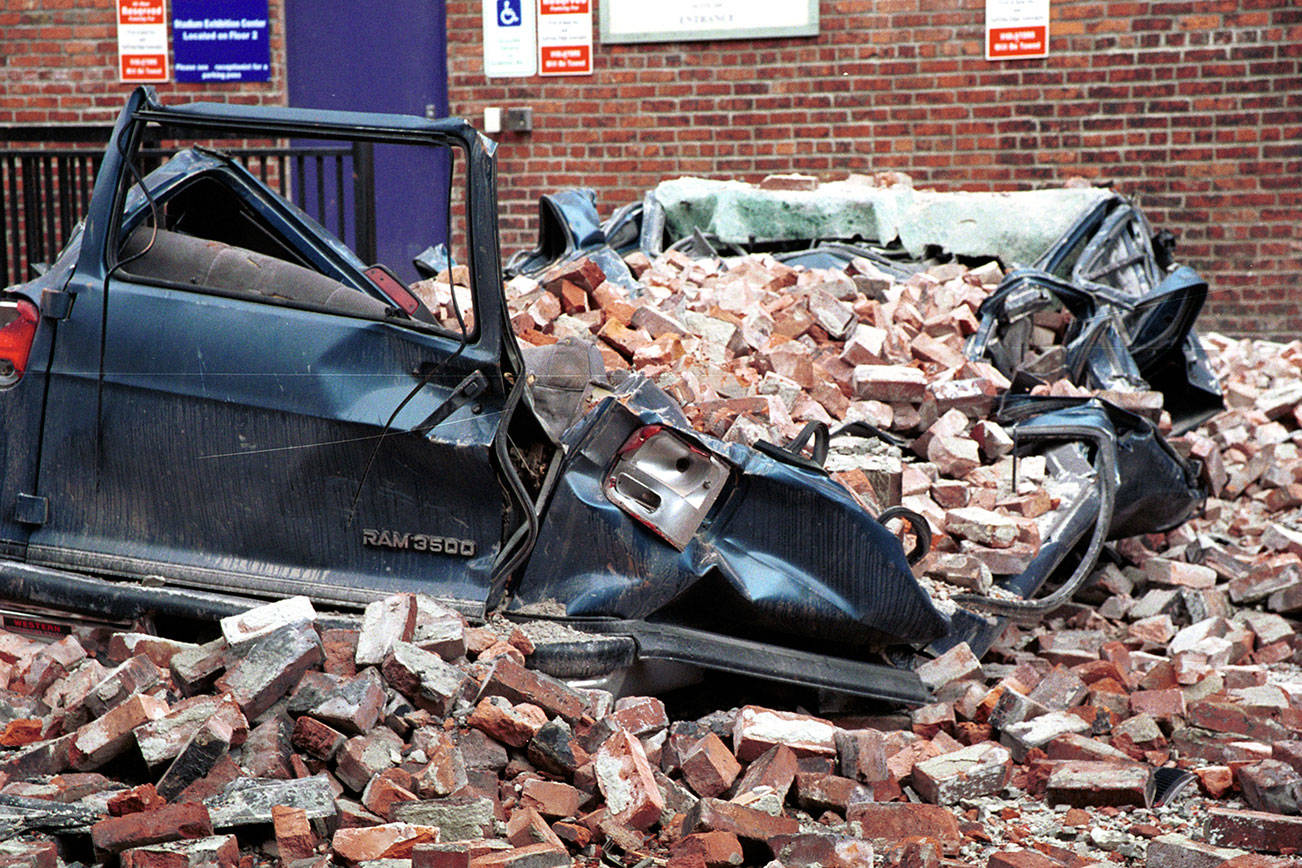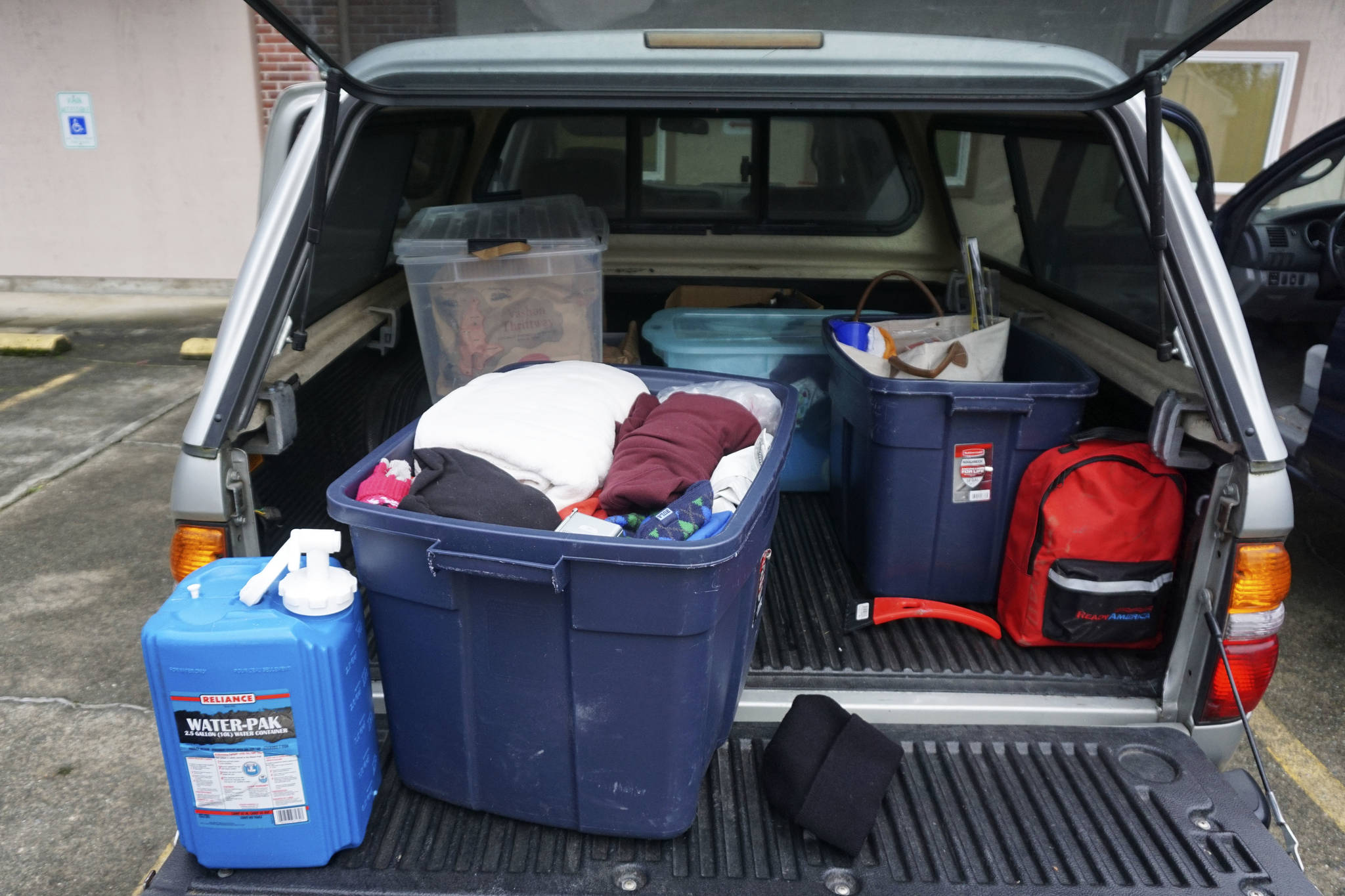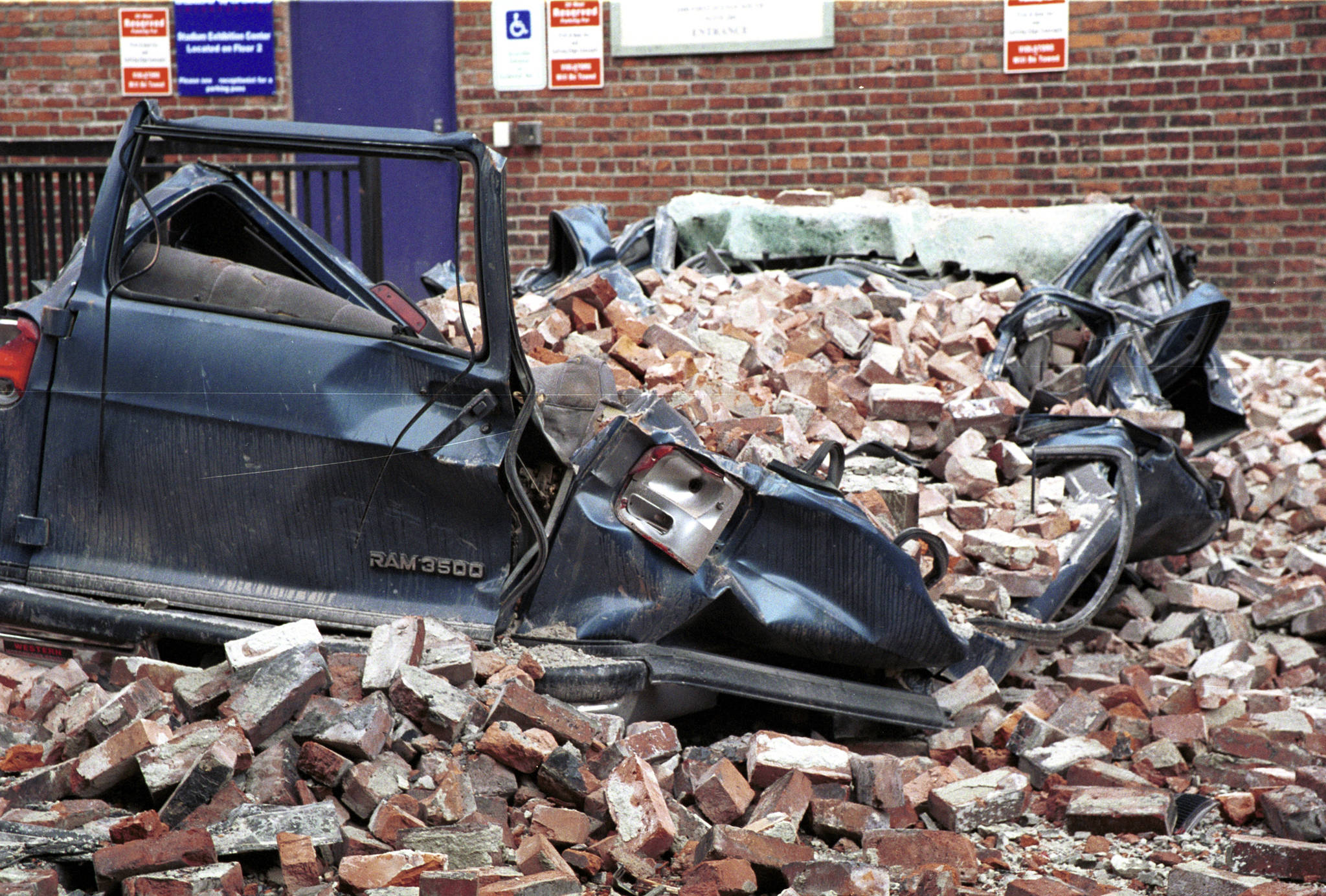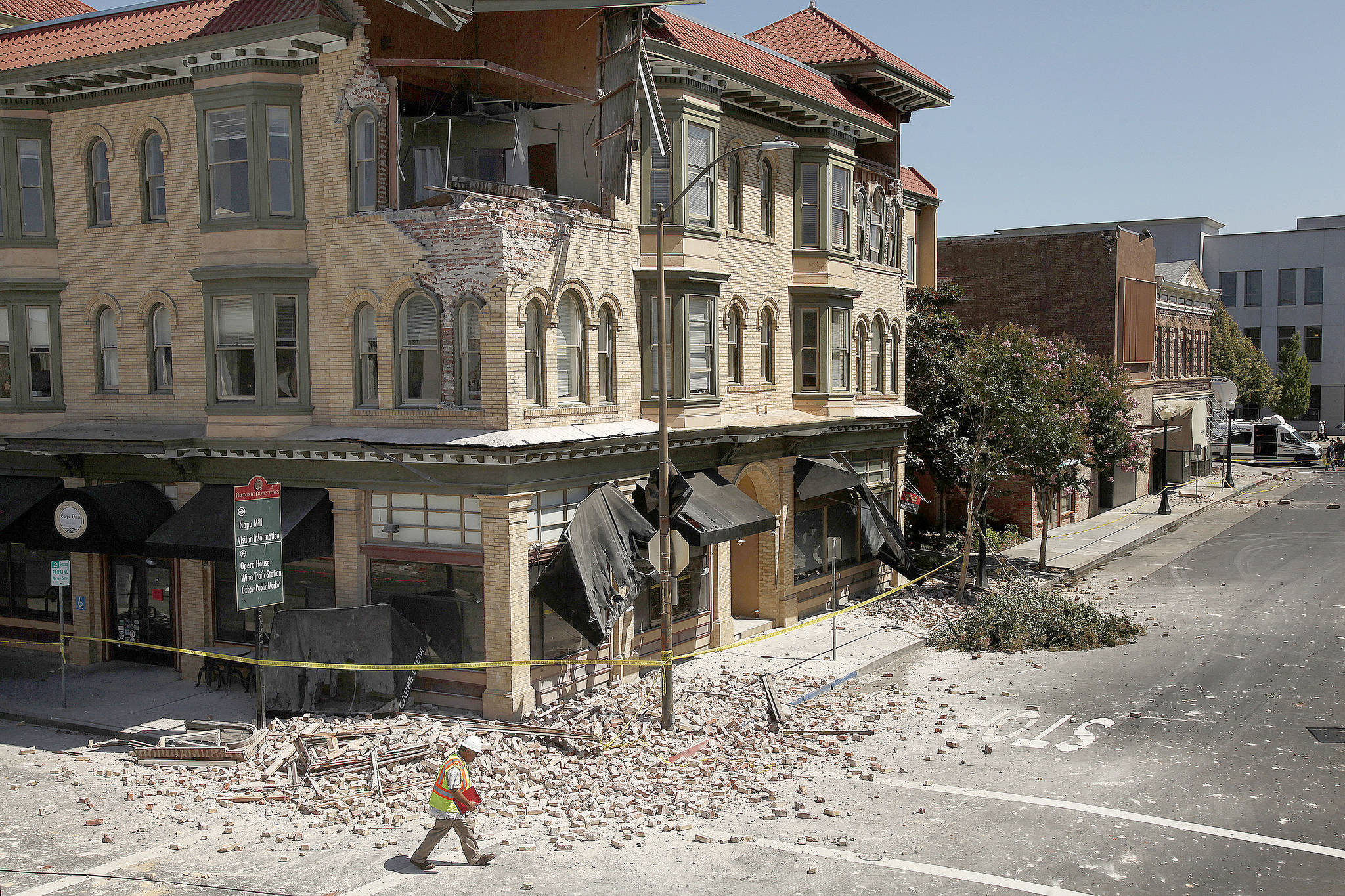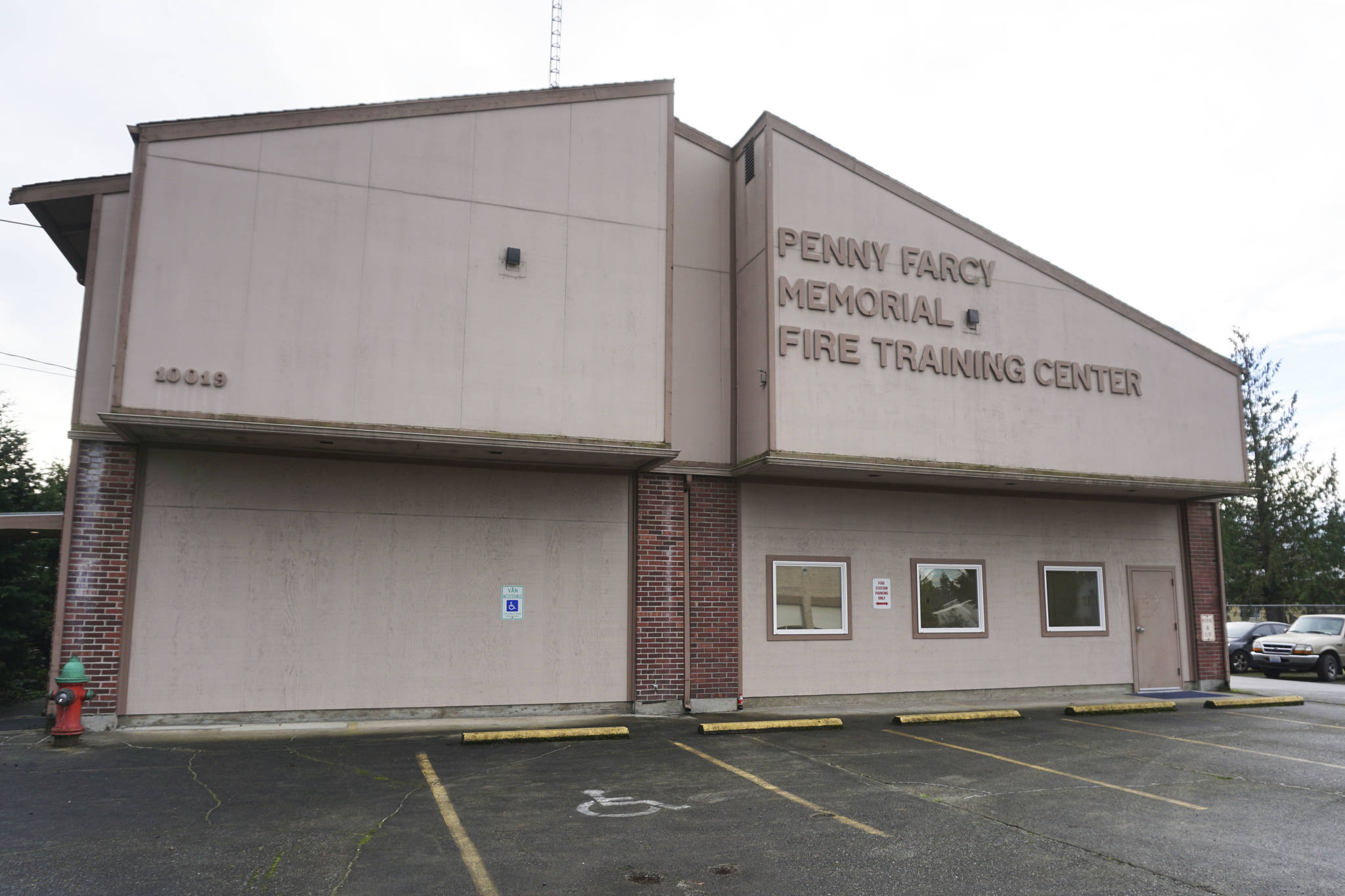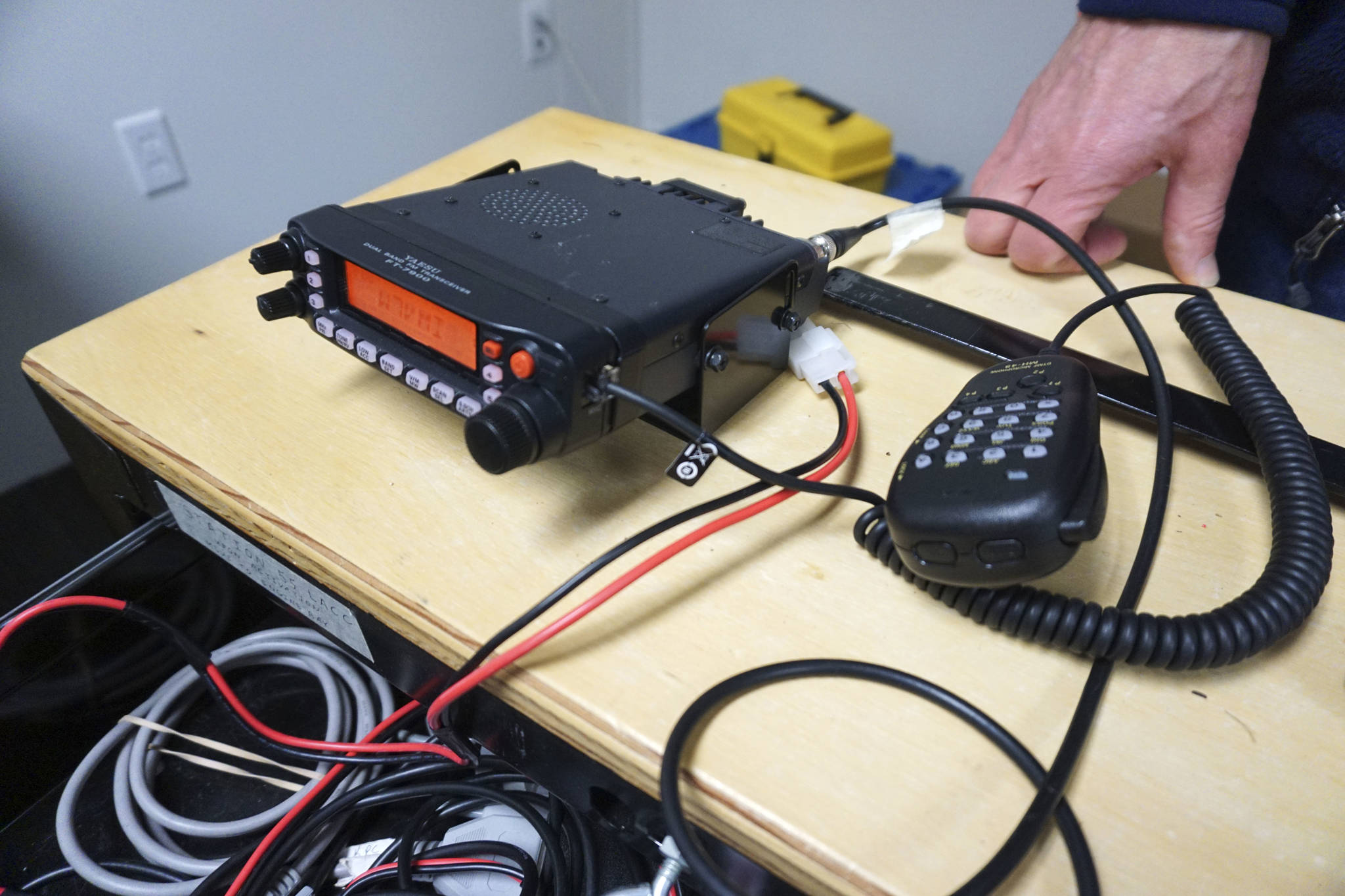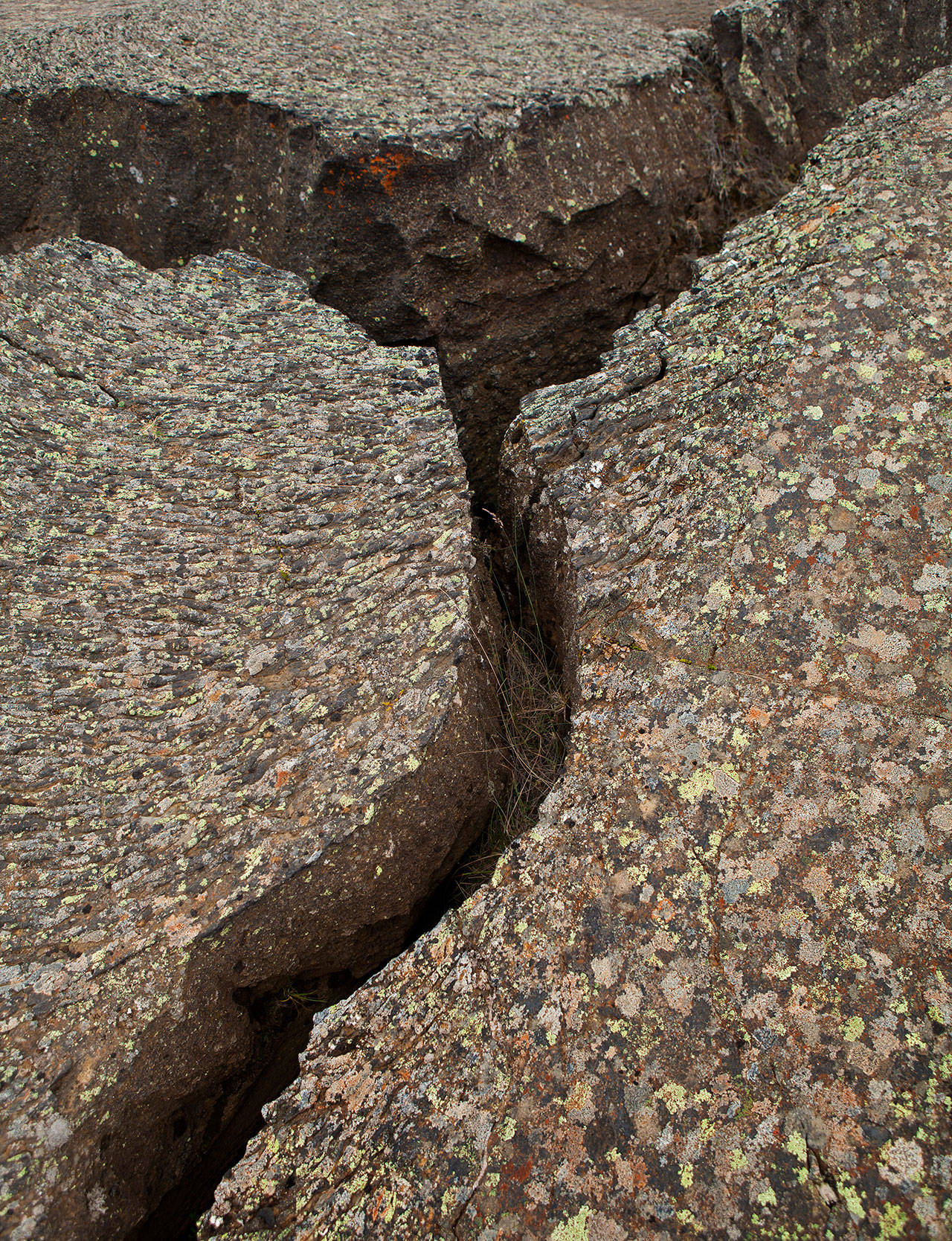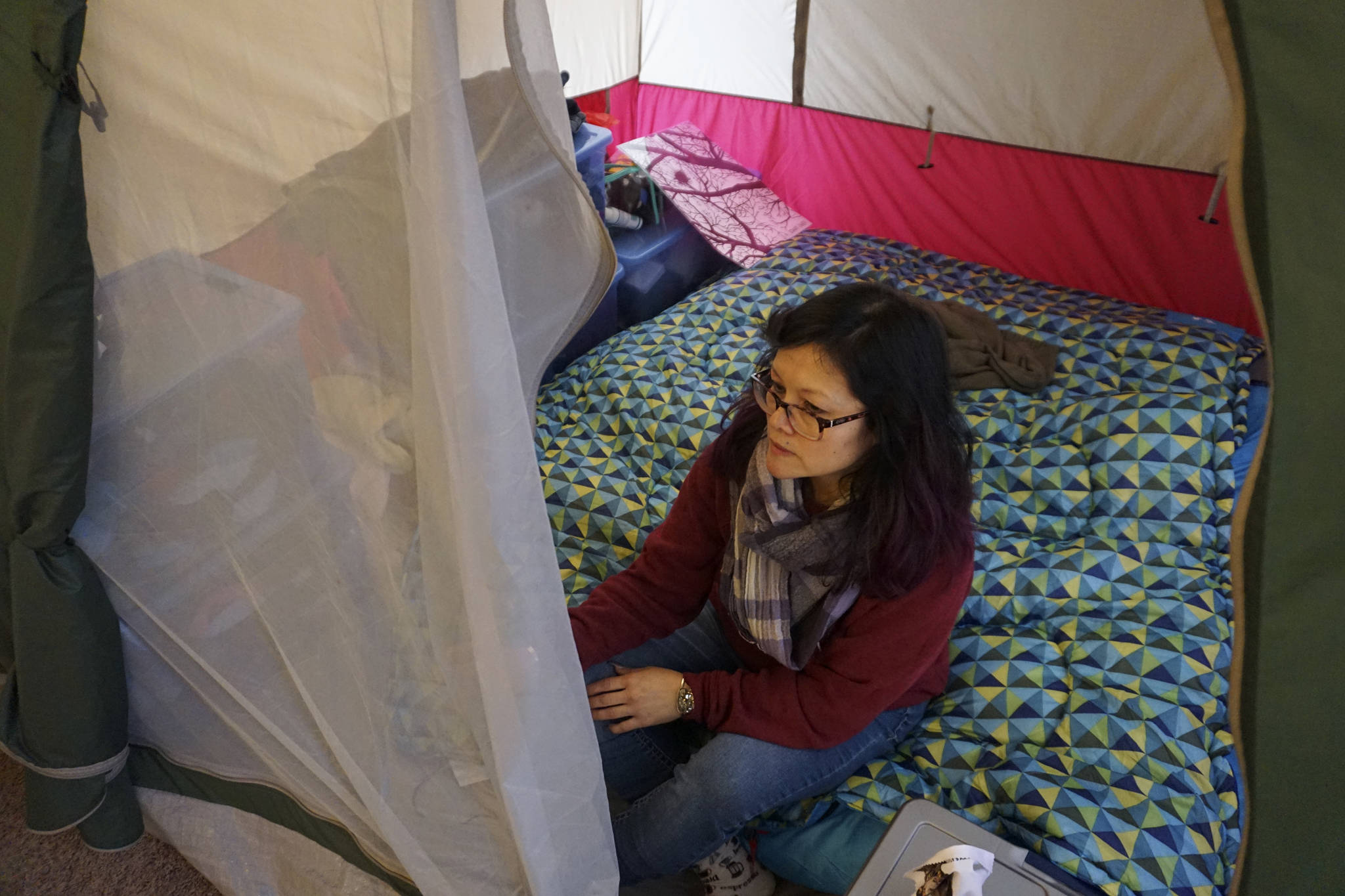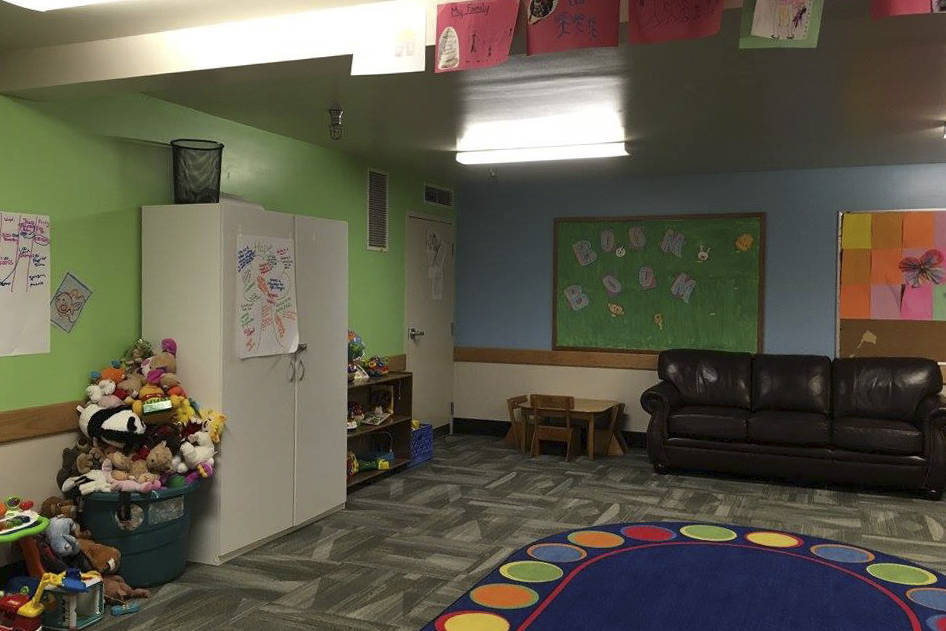Vashon Island resident Vicky de Monterey Richoux keeps fully stocked emergency kits readily available at all times, much as some people keep spare pairs of glasses casually strewn about rooms or cars. On a recent Friday afternoon, she stood outside of the island’s fire training center with her car’s trunk pried open to reveal several plastic tubs. Removing the lid of one large blue container, she explained the contents: “Extra clothing, there’s a real warm jacket,” de Monterey Richoux said in a soft voice as she placed clothes from the bin onto the trunk bed. “I save my old stuff that doesn’t look nice, but I’m happy to lay under the car with it; first aid kit, safety vest, rain jacket, a blanket for my grandson,” she said as the pile steadily grew.
As the President of VashonBePrepared, a coalition of disaster-preparedness organizations that helps coordinate volunteers to reduce the impacts of catastrophes, de Monterey Richoux is vigilant about stockpiling supplies that will come in handy in an emergency. Originally started as the Vashon Disaster Preparedness Coalition in 2002, VashonBePrepared became a nonprofit in its current iteration five years later.
While this rural island of about 11,000 residents is often recognized by travel magazines as a getaway destination for restless Seattleites, it’s also gaining recognition for its population’s resiliency: a trait in short supply that’s become increasingly coveted as the threat of catastrophe looms nearer.
“In general around the state, we have a very large reputation for being prepared,” VashonBePrepared Vice President Rick Wallace said as he sat beside de Monterey Richoux in the island’s fire training center. “What we always tell people is: If we’re all that prepared, God save all the other people,” Wallace said with a laugh.
When the big one hits, people will need saving one way or another. Seismologists predict a 14 percent chance of a large Cascadia Subduction Zone earthquake occurring in the region within the next 50 years. Though it may not happen in that timeframe, it’s a matter of when, not if. The last known subduction earthquake in 1700 sent massive tsunamis barreling across the Pacific in all directions, striking the coast of the Pacific Northwest and Japan. According to the Pacific Northwest Seismic Network, geological records indicate that such an earthquake has happened seven times in the past 3,500 years, meaning the destructive forces usually return in 400- to 600-year intervals.
A 2015 New Yorker article brought the issue into focus for the millions who would be affected by a massive earthquake in Washington, Oregon, and California. The article notes that FEMA expects 13,000 people to die in the earthquake, while an additional 27,000 people will be injured and millions displaced. Additionally, infrastructure will be crippled, and the Washington State Department of Natural Resources anticipates an economic impact of $70 billion. Despite these dire predictions, the inevitable earthquake and the destruction it will bring have become something of a cultural meme, even as government agencies quietly prepare for the worst.
Earthquake Risks
Earthquakes cause destruction in a number of ways, but for large ones the damage can be divided into three broad categories: shake damage, tsunamis, and fires. A magnitude-9.0 earthquake will shake for more than four minutes, buckling roads and bridges, collapsing buildings, and disrupting water systems.
Soil liquefaction, in which solid ground behaves like liquid and partially loses its ability to support buildings and structures above it, stands as another projected problem. The cities of North Bend and Carnation are almost entirely in liquefaction zones, according to King County data, as is much of the land near the Snoqualmie River. Areas on either side of the Interstate 5 corridor from South King County to Seattle’s Westlake neighborhood, as well as portions of Magnolia and the University District, are also highly susceptible to liquefaction.
Water factors into earthquake damage in two ways: the first would come from a tsunami, which is expected to hit Washington’s coast the hardest. However, neighborhoods along Elliott Bay and Puget Sound in Seattle would also suffer damage from a tsunami.
Following the earthquake and tsunami, the affected areas could begin to catch fire, according to Grace Kang, a structural engineer and director of communications for UC Berkeley’s Pacific Earthquake Engineering Center. “I would imagine that King County would be vulnerable to not only the shaking and to tsunami risk, but fire following an earthquake,” she said. Such fires often start from broken gas lines that ignite and will require a large firefighting effort to counter.
Here’s the second water factor: A study recently published by Seattle Public Utilities found that all water pressure in its system could be lost within 24 hours following a magnitude-7.0 or higher earthquake. This would come at a critical time for firefighting efforts. Fire agencies generally have the ability to siphon water from rivers and lakes into trucks and tankers, but such a process requires access to the water.
While much attention is paid to the larger Cascadia Subduction Zone earthquake, a lesser-known danger comes from the Seattle Fault zone, which has around a 20 percent chance of creating a magnitude-6.5 earthquake in the next 50 years, the Seattle Public Utilities report says. The report also notes that another earthquake similar to the magnitude-6.8 Nisqually shake is nearly inevitable in the next half-century.
Such high-magnitude earthquakes could damage water infrastructure by rupturing main water pipelines that serve Seattle and surrounding suburban cities. The report found that it would likely take one month to restore around 70 percent of service, an additional month to restore service to all customers, and years until reliability and service levels would return to normal. Repairs to larger arterial pipelines in difficult places to reach, like those buried beneath rivers or on steep slopes, could remain in disrepair for six to eight weeks.
Completely replacing all vulnerable water systems comes with an estimated price of $19 billion, an amount the report said was not economically feasible over a short period. Instead, the report recommended improving emergency preparedness and response planning, which would cost up to $40 million over the next 20 years. The report also suggested SPU begin upgrading transmission pipelines, buildings, and water-storage facilities, as well as constructing new facilities under current seismic code. These long-term investments could cost more than $800 million over the next 50 years, and would be followed by additional investments for decades.
In addition to the potential repercussions of failed infrastructures, Seattleites also face the risk of residing in buildings that could slide off of their foundations during an earthquake. According to December 2018 Seattle Department of Construction and Inspections (SDCI) data, the city holds 1,141 unreinforced masonry structures: buildings without steel reinforcement or connections between the walls and foundations, which makes them vulnerable to collapse during earthquakes. Seattle neighborhoods with the highest number of buildings at a critical or high risk of collapsing in an earthquake include Pioneer Square, the University District, Capitol Hill, and Duwamish/SODO.
Formed in February 2012, SDCI’s unreinforced-masonry policy committee consists of seismologists, historical preservationists, housing and real-estate representatives, property owners, structural engineers, and architects who create suggestions for a citywide policy on retrofitting seismically weak structures. The policy committee released a list of final recommendations in August 2017 that included the requirement that all buildings with unreinforced masonry walls be retrofitted, except for those in duplexes or single-family homes. Other suggestions included creating an enforcement mechanism for buildings that have not fulfilled the retrofitting mandate and requiring a seven-year timeline for critically vulnerable buildings to be reinforced. “The City of Seattle contracted with an outside organization to study the information gained during the policy development and subsequent meetings with stakeholders. Their expertise in the economics of the proposed policy will inform the Mayor’s office about the impact of the proposed ordinance,” SDCI spokesperson Bryan Stevens wrote in an email to Seattle Weekly. “They will be providing their final report to the City in the first quarter of 2019.” The joint effort between the Office of Emergency Management and SDCI seeks to explore financial options for property owners required to make mandatory seismic retrofits to their buildings.
“Every time that there’s an earthquake, the world is learning more,” said Seattle Office of Emergency Management spokesperson Cornell Amaya, referencing the lessons structural engineers and seismologists gleaned from destruction caused by the magnitude-6.3 earthquake that stuck Christchurch, New Zealand, in 2011. Places recently struck by earthquakes, such as Christchurch, have begun retrofitting their water infrastructure to withstand future earthquakes. UC Berkeley’s Kang said that city officials in San Francisco have begun researching ways to use several underground cisterns in the event of a large earthquake that would damage water infrastructure.
Preparing for large disasters, manmade or natural, goes beyond infrastructure. It also includes community response and the ability of neighbors to work together and help one another while emergency responders are stretched thin. One such resource is known as CERT, or community emergency response teams. Kyle Ohashi, public-information officer for the Puget Sound Regional Fire Authority that serves several South King County communities, said there is still much to be done—although they have already trained around 1,500 volunteers. “There is no community that I know of in this area that is sufficiently prepared for a disaster. None of us are,” Ohashi said.
One reason why the response to the near-certainty of a large earthquake striking Puget Sound is more muted than in other parts of the world may be because of its relative rarity, Kang said. “It’s not like the West Coast is like Japan where earthquakes are experienced on such a frequent level that people are aware of it all the time,” she said.
Solutions
While experts agree that there is a need for more preparation, jurisdictions throughout the Puget Sound region have bolstered efforts in recent years to address seismically weak infrastructure and raise awareness.
Vashon Island, where Wallace and de Monterey Richoux reside, is one such community that has strengthened its response efforts out of necessity. Members of VashonBePrepared realized just how isolated the island would be during a disaster in the wake of a four-day exercise called Cascadia Rising 2016 that tested the disaster response of emergency operation centers throughout the region. During the drill, over 20,000 federal, tribal, local, and state partners in Idaho, Oregon, and Washington staged simulations of the days following a magnitude-9.0 earthquake and tsunami to ascertain response and recovery plans. The exercise revealed that state and local governments needed to create more robust disaster-response systems.
Following Cascadia Rising, funding from Vashon Island Fire and Rescue,VashonBePrepared, and $10,000 from Puget Sound Energy Foundation helped to renovate Penny Farcy Memorial Building, which serves as the training center for the island’s fire department. The building will also transform into a communications center and operations command post in the face of an emergency.
“We’re just occupying the space now, and we’re developing the systems we’ll use to activate it,” Wallace said as he stood in a room with rows of chairs stacked atop long tables. In the quiet, dim space it takes a stretch of the imagination to envision the room as the bustling brain of the operation center in which volunteers will support professional responders during a disaster. Wallace walked through a hallway to a communications center that will be staffed by amateur radio operators and scribes who will relay status reports of critical locations to the community. “If traditional telecommunications are down, this is our connection to the King County Office of Emergency Management,” Wallace said.
The existence of VashonBePrepared is as variable as a community’s wide-ranging needs that follow a disaster. VashonBePrepared would lie dormant in the wake of an earthquake, instead shifting response tasks to its partner organizations. The operation center would hold volunteers, Vashon Island Fire and Rescue staff, and additional emergency personnel, such as the United States National Guard.
Cascadia Rising’s drill two years ago painted a scenario in which the island’s assisted-living facility would face so much damage that it would need to be evacuated; fuel would run out four days after the earthquake; and a transformer vault would catch on fire, according to a 2016 Vashon-Maury Island Beachcomber report. The exercise underscored the necessity of neighborhood preparation and a need for more volunteers, which have since grown to about 200 residents.
During the exercise, local CERT members worked with the Washington Army National Guard to practice loading patients in critical condition into a helicopter at Vashon’s Sunrise Ridge. The helicopter rescues could also be used during an emergency, given that the island lacks a hospital.
Takeaways from Vashon’s Cascadia Rising exercise reflected that of emergency-response operations throughout the region. The Washington Military Department’s 2017 report that outlined findings from the exercise deemed the state’s catastrophic-response plan inadequate. Among other suggestions, the report’s authors recommended that the state government prioritize emergency preparedness; that a state funding mechanism be created to facilitate preparation efforts; and that interagency plans be developed to support transportation, sheltering, and public health.
While state officials previously warned residents to be prepared for 72 hours, Cascadia Rising also revealed that projected delays in assistance would require the public to plan for at least two weeks of isolation. In response to the exercise, the state has bolstered its response approach by completing a fuel contract that seeks to provide emergency personnel with speedy access to fuel following an earthquake. A recent memorandum of understanding between the Washington Military Department and a team of volunteer structural engineers, building officials, and architects will allow the experts to determine what buildings will be safe to re-enter following an earthquake. The Washington Emergency Management Division plans to hold the next large-scale exercise that will expand on Cascadia Rising in 2022.
Puget Sound emergency responders and volunteers said one of the most important aspects of preparing for disasters comes from community organizing, like that found in CERT teams. Ohashi said it’s important for people to know what to do after the shaking stops. “Fire departments, police departments, all emergency responders are going to be overwhelmed by the sheer magnitude of what’s happening,” he said.
These teams are trained by local emergency responders and cover topics such as disaster preparedness, basic firefighting, first aid, light search and rescue, team organizing, and disaster simulations. Being prepared includes having enough food and water for two weeks, with a recommended quantity of one gallon of water per day per person. For people living in small apartments without storage space, Ohashi said tubs and sinks can be filled with water, and hot water tanks can also provide a source of drinking water. Extra medication, spare glasses, and batteries are also important parts of an emergency kit. Several CERT trained individuals live in Seattle, and many more are trained on the Eastside and south end, including teams in Bellevue, Issaquah, and Kirkland. The program offers classes multiple times a year.
Along with prioritizing community organizing, Seattle has made gains in recent years in repairing or replacing infrastructure considered to be at risk of collapsing during an earthquake. According to Seattle Office of Emergency Management spokesperson Amaya, the city has invested in retrograding and retrofitting the seawalls to meet current seismic standards. Additionally, the city has also upgraded its fire stations: “Here is one of our main sources of emergency rescue and getting out to help and treat people after an earthquake,” Amaya said. “[But] they were in buildings that weren’t seismically sound to do that.” He also highlighted the city’s removal of the Alaskan Way Viaduct, which will close on Jan. 11, 2019, to be replaced by a bored road tunnel.
The city’s Department of Construction and Inspections also offers a reduced cost of permits through a program called the Earthquake Home Retrofit Permits (formerly known as Project Impact), consisting of prescriptive plans for homeowners interested in retrofitting their homes. “The whole objective is to get the building to move as one entity,” Amaya said.
The FEMA-certified retrofitting company Sound Seismic has protected about 2,000 Seattle homes against earthquake damage for nearly 20 years, some of which were retrofitted under permits obtained through the city’s Project Impact program. “I want to make it so that when my clients get home after an earthquake … not only is their home survivable, but its livable,” Sound Seismic owner Leif Jackson said.
Although retrofitting homes is his specialty, Jackson is more concerned about the potential havoc caused by seismically weak infrastructure than crumbling houses. “Roads, bridges, water lines, power lines will be damaged in ways I don’t think any of us can comprehend,” he said.
In his work, Jackson encounters many homeowners who are individually preparing for an earthquake with emergency kits and water that will last for a few days, “but I think most of us could do so much better,” he added. Jackson recommended that people also keep kits at their jobs and in their vehicles.
Amaya echoed Jackson’s suggestion that residents create plans for different scenarios that might occur during an earthquake. For instance, families should consider establishing a safe place where children can wait if they’re separated from their parents who are at work. “It’s a huge goal to get people to take some initiatives to get prepared,” Amaya said. The Office of Emergency Management’s website lists suggestions on building a seven- to 10-day emergency kit that includes packing high-caloric food that’s easily preservable, battery-powered flashlights, a change of clothing, and a first-aid kit.
All jurisdictions throughout King County work with the county’s emergency management office to exercise public outreach, regional responses, and operation plans. The regional disaster planning takes an “all-hazards approach,” wrote King County’s Emergency Management Program Manager Sophia Lopez in an email to Seattle Weekly. “Being prepared for one hazard prepares us for many,” she added. The emergency management office has specific tips and checklists on its website for earthquakes, which includes suggestions such as crouching to the ground and staying clear of power lines, trees, and structures when outdoors during an earthquake. Working in partnership with the King County Library System, the county also offers free disaster skills training twice a month throughout the region.
During a magnitude-9.0 earthquake, “we would activate our emergency operations center to coordinate and prioritize repairs and restorations with regional partners such as [Puget Sound Energy] and other utilities, [Washington State Department of Transportation], city road departments, telecommunications, rail, and other government and private entities,” Lopez wrote. She reiterated the sentiment that building relationships with other community members and personal preparedness goes a long way during a disaster.
A National Model
Meanwhile, Vashon Island has been hailed nationally as a leader in emergency preparedness, with research students from Georgetown University in Washington, D.C., making annual treks to the small Puget Sound island to learn from volunteers each year. In addition to VashonBePrepared’s coordination of emergency planning between different agencies, the island boasts between 50 to 100 active CERT members, with hundreds more trained for the job. These teams have been used many times for search-and-rescue operations.
Along with CERT members, Vashon hosts neighborhood emergency-response organizations (NEROs): informal groups of neighbors who coordinate to help after disasters. The groups meet at least once a year to become acquainted and to create plans to check on one another during emergencies.
Wallace, Vice President of VashonBePrepared, said most of the island’s emergency-response plan relies on regular residents. “We’re very volunteer-driven here because we have to be,” he said. It’s the perennial sense of isolation that Vashon experiences as an island that serves as a benefit in disaster preparedness, according to coalition members: “There’s something about being surrounded by water that concentrates the mind,” Wallace quipped.
All food, fuel, and necessities must be shipped onto the island, which is accessible only by boat or aircraft. However, de Monterey Richoux said that during a natural disaster such as an earthquake, many mainland residents would likely find themselves in a similar situation: cut off from outside aid, at least for a while. “We already get that we’re isolated. Folks on the mainland may not realize the extent that they will be isolated,” she said.
The community’s response has been to promote individual and household preparedness. Consequently, there are roughly 230 neighborhood organizations on the island, largely thanks to organizing efforts by VashonBePrepared and de Monterey Richoux.
The island’s relatively small size will make it easy for responders to check infrastructure, including its single school campus, four gas stations, and two supermarkets. The group additionally publishes an annual emergency preparedness insert for the Vashon-Maury Island Beachcomber, and the island has its own webcasting station that can be utilized during disasters.
Vashon residents have already grown familiar with a mindset of self-reliance that may feel foreign to others throughout King County when disaster strikes, de Monterey Richoux said. A recent community survey answered by around a quarter of the island’s population found that 90 percent of respondents had at least the recommended amount of a three-day supply of food and water, which has since been increased to a two-week supply. This general awareness has been carefully promoted by VashonBePrepared through frequent reminders and community engagement. “Our roots aren’t just wide, they’re deep,” Wallace said.
According to de Monterey Richoux, there are three main reasons why people don’t prepare for disasters: anxiety, a distrust of the message or messenger, and fatalism. Starting preparation can be as simple as buying a few extra bottles of water or cans of chili during a shopping trip, she said. The organization also successfully ran an advertising campaign asking people what would happen to their pets in an emergency as an attempt to reach people plagued by fatalism.
Even while VashonBePrepared may not be as prepared as Wallace would like, it may fare better than many areas of the mainland. “What we have is a strength of community,” Wallace said. “There’s a culture here of taking care of yourself that doesn’t exist on the mainland.”
mhellmann@seattleweekly.com akunkler@soundpublishing.com
Correction: The story has been amended to clarify the structures that qualify for the Earthquake Home Retrofit Permits program.
